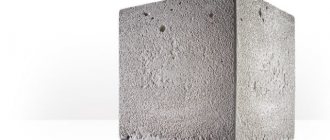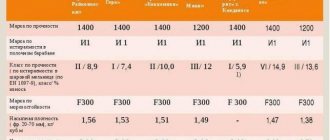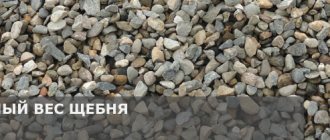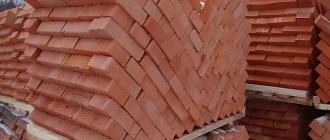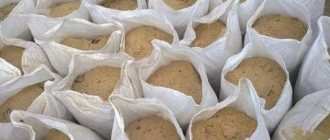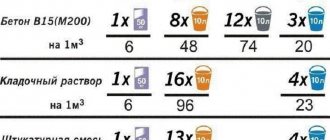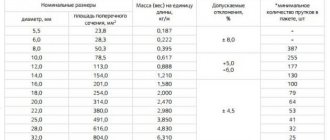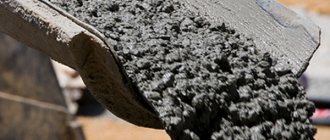In construction, it is often necessary to calculate the weight of various structures in order to have an idea of the load-bearing capacities of building supports and the necessary installation work. Knowing how many kilograms are in 1 cubic meter of concrete, you can accurately determine the thickness and width of the foundation, the size of the wall, as well as the area of contact and the depth of the foundation. In “amateur” construction, the weight is usually considered to be 2.5 t/m3, but in fact the value is non-static. The weight of 1 cube of concrete varies greatly depending on the composition and type of mixture; there are both light types of concrete and heavy, reinforced varieties.
Component composition of concrete - what determines the weight of 1 m3
Depending on the brand of concrete, the cement mixture is mixed with water. Fillers are mineral natural bulk ingredients - sand, gravel, crushed stone, expanded clay. The ratio of composites determines the strength of concrete after hardening.
Each of the minerals has its own bulk density, from which the volume of the additive is calculated, depending on the brand of concrete being mixed. But, in a liquid solution, their total quantity by mass does not correspond to the weight. The specific gravity of 1 m3 of concrete depends on the quality of the mix, the amount of water, and the presence of voids inside the granules.
Components of a concrete mixture: the importance of a competent combination of components
Errors in calculations when designing a concrete structure can lead to subsidence and deformation of the entire structure, up to complete destruction. The weight of a cubic meter of concrete solution is one of the significant quantities in design work. The mass of the mixed concrete mixture directly depends on:
- quantity and quality of cement of the required brand - if cement is stored for more than 3 months, it gradually begins to clump, which is why the bulk density decreases. Ultimately, the consumption of such cement increases significantly;
- type and fractions of crushed stone - fine-grained crushed stone compacts the mixture better than coarse-grained crushed stone of the same type. High-quality filling of small voids in the solution with small stones makes the concrete heavier. Granite crushed stone itself weighs more than others, as it has a dense structure;
- added additives;
- the required amount of water and sand - when working with wet sand, less water is required so that the solution does not turn out to be too liquid;
- mixing method - a solution prepared by hand is at least 5% lighter than one mixed at the manufacturer.
The volumetric weight of the structure decreases over time due to the evaporation of moisture during the hardening of the concrete mixture. All this is taken into account by specialists when calculating the exact weight of the future concrete structure.
Concepts of specific and volumetric gravity for concrete
It is difficult to determine the specific content of dry, crushed and compressed residue. Therefore, it is customary to record concrete according to the indicator “volumetric weight” in liquid and dry state, which corresponds to density in kg per cubic meter. Volumetric (density) and specific gravity are different characteristics of a physical substance, but in this case they coincide and are marked with the letter D.
Table: Volumetric (specific) gravity
| Marking | Liquid state (kg/m³) | Dry condition (kg/m³) |
| M100 | 2366 | 2180 |
| M150 | 2360 | 2181 |
| M200 | 2362 | 2182 |
| M300 | 2358 | 2183 |
| M400 | 2350 | 2170 |
| M500 | 2355 | 2180 |
How many kg of cement per 1 cubic meter of concrete?
To produce 1 m3 of high-quality concrete, 366 kg of M400 material is used. If the cement base is M500, then 319 kg of raw materials are used. If you want to know how many bags of cement are needed per 1 m3, then for M500 use 4.26 bags.
Interesting materials:
How is this a stabilized rose? How is this a technical knockout? How is this spring exacerbation? How is this out of competition? How to filter content on YouTube? How to convert PNG format to jpg? How is an email address generated? How are the State Duma and the Federation Council formed? How is the second law of thermodynamics formulated? How do traffic cops mark your license?
Dependence of the specific gravity of concrete on the component composition
Any concrete consists of cement, water and fillers. Its density will be higher, the less porous materials there are in the mixture. And the weight will be higher if a heavy fractional composition is used. Therefore, concretes are divided into classes according to their composition and application.
The volumetric weight of the composition shows the ratio of mass without pores to volume, expressed in kg/m3 or g/cm2. Taking into account the fillers used, compositions have been developed for concrete of low, medium and high strength.
When composing the composition, the following are taken into account:
- the smaller the filler size, the fewer voids, the heavier the composition;
- use of filler of optimal density.
- the less water in excess of the need for cement hydration, the more voids after hardening:
- heating and compaction increase mobility and promote tight styling;
- the presence of plasticizers reduces the amount of water in the batch.
Composites are created taking into account all the requirements for fillers; their technical characteristics differ to ensure variability of use. The guideline is the strength indicator - grade “M” in kgf/cm2 and “B” in MPa.
The variability of compositions makes it possible to obtain building mixtures of different strengths. Gravel or crushed stone of different density sizes, sand of 3 fractions, expanded clay of different sections can be used. All components influence the specific gravity of concrete and its strength characteristics.
Application of masonry sand concrete
Working with the M150 requires compliance with certain rules. But they are no different from the procedure for using other building mixtures of this type.
We invite you to familiarize yourself with Propolis: properties and applications. How to benefit from propolis?
If this is a wall, then it must be completely freed from dust and dirt, plant debris, etc.
Cleaning the wall
If there is old plaster, it is removed in those places where it does not hold firmly. Only after this will it be possible to apply a new solution.
Removing old plaster
But for this it needs to be prepared. For plastering walls, the proportion is as follows: for 10 kg of M150, 2 liters of water. It is advisable to take it clean and cold, but not very cold, about 15 C. If necessary, you can add more liquid.
The solution is made like this. The mixture (dry) is gradually added to the water and mixed. When the mass becomes homogeneous, let it stand for about 5 minutes. And then it must be quickly mixed again. The batch should be worked out within 2 hours.
Preparing the mixture
Application with a spatula
If work is carried out from the outside, then before doing this the surface should be reinforced using reinforcing mesh.
Application to reinforcing mesh
M150 is considered a universal brand among similar cement-sand mixtures. It behaves well during various technological operations. This mixture, if necessary, can replace any other. That is why it is in demand in the construction market.
Types of cement building mixtures by volumetric weight
Depending on the composition of the fillers and their proportions, concrete is divided into classes based on volumetric weight and strength. Within the class, composites are divided into grades intended for use in a specific field of construction.
Concretes are:
- Extra light, D50-500
- Light cellular, D 500-1200
- Light, D 1400-1800
- Lightweight, D 1800-2200
- Heavy, D 220-2500
- Extra heavy, D< 2500
- D – volumetric weight kg/m3.
Characteristics and composition of thermal insulating concrete
Thermal insulating concrete is characterized by the low weight of the filler due to its high porosity. They are light in weight, but in the open air they absorb moisture and do not have load-bearing capacity. It is laid as an insulating layer. Includes:
- Cement – 44-47%.
- Montmorillonite clay with the inclusion of 0.6% minerals, up to a total of 13.8%.
- Foaming agent up to 0.5%.
- Pure industrial water – 40-43%.
The resulting composition is poured into a prepared backfill made of expanded clay or polymer materials with a neutral reaction.
Characteristics of lightweight concrete
Compositions with a volumetric weight of less than 2000 kg/m3, cellular, aerated concrete for lightly loaded structures are called lightweight.
Based on the composition of composites, lightweight concrete is divided into types:
- Fatty, slag concrete with a dense composition.
- Skinny, with slag and sand.
- Cellular fine-porous aerated concrete and foam concrete.
- Large porous, no filler.
Different structures are created by using the brand and type of cement and the use of tuff, ash, slag, excluding heavy ones - brick chips, crushed stone. The finished mixture should be mobile, but not contain excess moisture.
Heavy concrete
Cement mixtures, including gravel, crushed stone and sand, are classified as heavy construction materials. Depending on the proportions of composites used, mixtures of grades M100-M500 are obtained. The specific gravity of a cube of concrete mixture varies depending on the proportion of inert materials and the type of crushed stone from basalt, granite, or gravel used.
Table of changes in specific gravity depending on the component composition in kg/m3
| Brand | Cement M400 | Sand screening | Crushed stone 5-20 mm | Ud. weight |
| M100 | 230 | 850 | 1200 | 2494 |
| M150 | 270 | 835 | 1180 | 2463 |
| M200 | 305 | 825 | 1170 | 2432 |
| <300 | 368 | 775 | 1160 | 2389 |
| M400 | 425 | 735 | 1080 | 2376 |
| M500 | 483 | 695 | 1080 | 2298 |
The water consumption per cube of the mixture was 140 liters.
Composition and use of especially heavy cement mixtures
For critical construction of military and especially dangerous facilities, super-heavy concrete is used. The specific gravity of special concrete depends on the fillers.
The use of not only special gravel, but metal, can help absorb radioactive radiation. The composition contains the mineral barite, which is capable of absorbing radioactive radiation.
The volumetric mass of barite concrete is 3700 kg/m3, its strength is 430 kg/cm2. The component composition is complex; the solution is mixed in special installations using new technologies. Limonite, hematite and magnetite ores are used in production. In special cases, cast iron and steel scrap are used as filler.
Comparison of the mass of concrete M300 with other brands
The average weight of concrete M300 (C18/22.5 according to GOST 7473-2010) differs slightly from grades M100–M500. A comparison of the weight of M300 concrete with other grades on gravel is clearly demonstrated in the table:
| Concrete grade | Weight of concrete mixture, t | |
| Dry matter | Liquid solution | |
| M100 | 2,180 | 2,366 |
| M150 | 2,181 | 2,360 |
| M200 | 2,182 | 2,362 |
| M300 | 2,184 | 2,389 |
| M400 | 2,170 | 2,350 |
| M500 | 2,180 | 2,355 |

